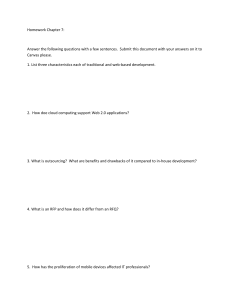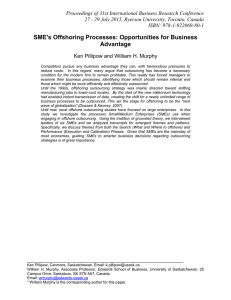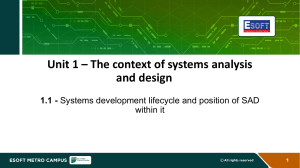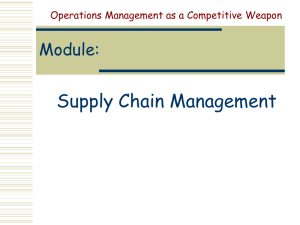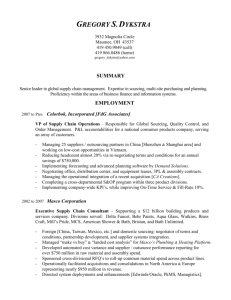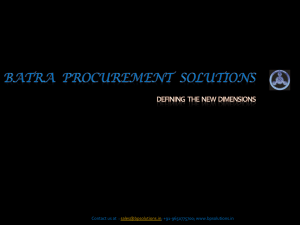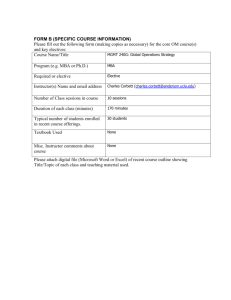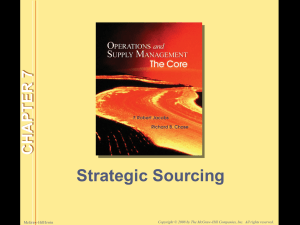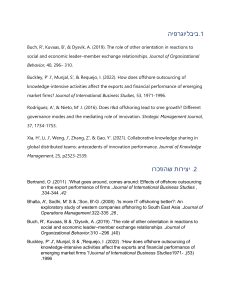Chapter 2
advertisement
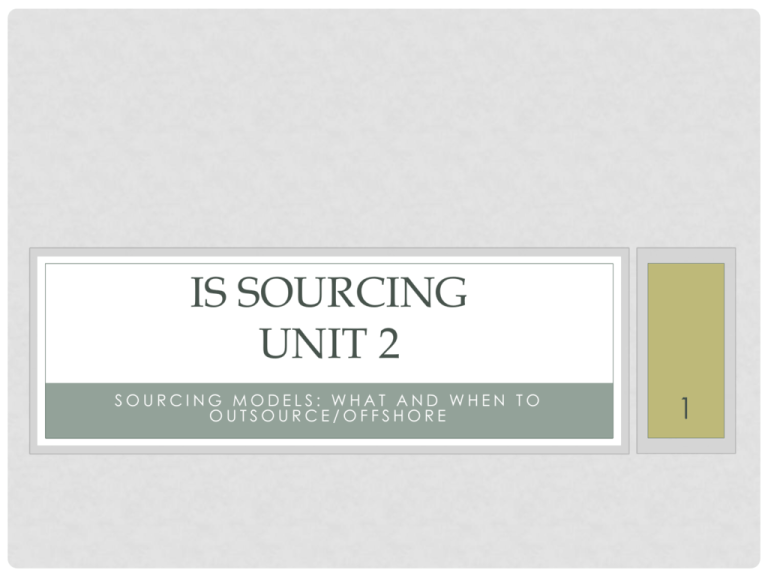
IS SOURCING UNIT 2 SOURCING MODELS: WHAT AND WHEN TO OUTSOURCE/OFFSHORE 1 FOUR SOURCING MODELS • • • • Domestic outsourcing Offshore outsourcing Domestic insourcing Captive models 2 OUTSOURCING SCOPE • Total outsourcing >80% • Total in-house sourcing <20% • Selective sourcing 20-80% 3 SOURCING CONSIDERATIONS 4 CRITERIA FOR DISTINGUISHING BETWEEN O/S MODEL TYPES • • • • • Resource ownership Resource management Customer/supplier relationship Location of supplier staff Type of contract Willcocks, et al 2006 5 FIVE OUTSOURCING MODELS • • • • • Time and materials model Exchange-based model Netsourcing model Joint venture model Enterprise-partnership model 6 7 VENDOR SELECTION • The careful selection of the “right” vendor is imperative • Consistent • Trustworthy, etc • Outsourcing is more successful when used for maintenance or valuable, but not vitally significant, components • …but, newer systems are becoming increasingly more important 8 Aka. Impact of IT on core operations • McFarlan & Nolan, 1995 Aka. Impact of IT on core strategy 9 FURTHER INFO ON THE STRATEGIC GRID • Levina notes that for offshoring, some adjustments are necessary • If activity has a high impact on operations, at least part of the activity needs to be onshore • Low impact on IT for both, it becomes difficult to decide • May require deep domain knowledge • Offshore vendors may not possess • Low impact on core, high on strategy (IP, data security sensitive info) • Levina suggests consider for outsourcing, but under careful mgmt • Some large vendors are specialized in security, etc 10 FACTORS INFLUENCING SUITABILITY OF PROCESSES FOR O/S • Not critical • Scale of process • Costs for searching, creating metrics, managing relationship may be too great for a small process • Projects may be too large as well….cost of mgmt too high for OS • Processes influenced by rapidly changing tech • Good candidates for O/S • O/S good for activities with high degree of variance 11 FUNDAMENTAL MISTAKES IN OFFSHORING DECISION-MAKING 1. Too little time spent evaluating processes • Difficulty defining: • “core” processes – inhouse • “critical” – buy from experts • “commodity” – o/s 2. Do not consider risks 3. Do not understand that o/s is not all-or-nothing 12 FACTORS INFLUENCING SUITABILITY OF PROCESSES FOR OFFSHORING • Substantial levels of comm – not offshoring • Value of processes to org – high value=no offshore • Rank processes by two criteria • Potential of value-creation • Potential of value capture 13 DECISION-MAKING MATRIX ON O/S • Order winners- contribute greatly to company’s business ops as well as competitive position • Qualifiers- critical for business ops; don’t add to competitivness (airline maintenance) • Necessary evils- don’t contribute (inv, payroll, etc) • Distractions- failed attempts to differentiate (Dell retail outlets) 14 15 IMPACT OF OPERATIONAL AND STRUCTURAL RISKS ON O/S AND OFF/S • Operational risk • Structural risk • With regard to operational risk…. • Eval extent to which processes can be codified and measured 16 4 TYPES OF PROCESSES • Transparent processes (transaction processing, tech support, etc) • Can be clearly measured; low operational risk • Codifiable processes (litigation support, yield analysis, etc) • Can be measured to some extent and most work can be codified • If final outcome measurement is not measurable, risk is high • Opaque processes (insurance underwriting, cash-flow forecasting) • Can be codified regarding work being done, but output quality hard to measure • Risk of off/s moderate but can increasing monitoring (at an expense) to help • Non-codifiable processes (supply chain coordination) • Cannot be codified • May not be able to measure quality achieved • High risk 17 IMPACT OF RISKS (CONT.) • Ability to monitor work and use metrics help define risks • TPS – easy • R&D – challenging • Cannot assume vendor works in client’s best interest • When O/Sing processes that require knowledge transfer, must invest in that transfer • Vendor learning curve may be steep 18 RISK MITIGATION FOR STRUCTURAL RISK • Contractual clauses • Continue with specified rate (+X%) after contract expiry date • Utilize multiple vendors • Easier to transfer • Competition 19 20 COMPLEX AND “PROBLEMATIC” BUSINESS PROCESSES • Process complexity adds risk • Criteria for complexity eval 1. 2. 3. 4. 5. 6. 7. 8. Codifiability of data to be transferred Training required Cost of monitoring performance levels Difficulty in assessing mgrs level of confidence that their quality assessments are true Desired ed level of employees Revenue per vendor Number of sub-tasks Single overall complexity measure 21 STEPS FOR PROCESS EVALUATION PRIOR TO DECIDING TO O/S • We don’t want to outsource to get rid of problematic processes. Thus, we need to evaluate each process to find root cause • Steps 1. Revamp business processes 2. Reinforce credibility and trust 3. Find the scale-economy sweet spot 1. Consolidation and standardization 22
